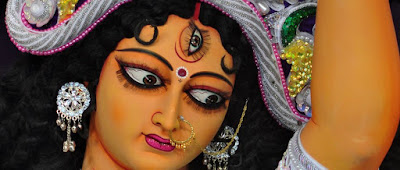What's Mahalaya?
Mahalaya is an auspicious occasion observed seven days before the Durga Puja,
and it heralds the advent of Durga, the goddess of supreme power. It's a
kind of invocation or invitation to the mother goddess to descend on
earth--"Jago Tumi Jago". This is done through the chanting of mantras and singing devotional songs.
Since the early 1930s, Mahalaya has come to associate itself with an
early morning radio program called “Mahisasura Mardini” or “The
Annihilation of the Demon.” This All India Radio (AIR) program is a
beautiful audio montage of recitation from the scriptural verses of
“Chandi Kavya”, Bengali devotional songs, classical music and a dash of
acoustic melodrama. The program has also been translated into Hindi with
a similar orchestration and is broadcast at the same time for a
pan-Indian audience.
This program has almost become synonymous with Mahalaya. For nearly
six decades now, the whole of Bengal rises up in the chilly pre-dawn
hours--4 am to be precise--on the day of Mahalayato tune into the
“Mahisasura Mardini” broadcast.
The Magic of Birendra Krishna Bhadra
One man who'll always be remembered for making Mahalaya memorable to
one and all is Birendra Krishna Bhadra, the magical voice behind the
“Mahisasura Mardini.” The legendary narrator recites the holy verses and
tells the story of the descent of Durga to earth, in his inimitable
style.
Bhadra has long passed away, but his recorded voice still forms the
core of the Mahalaya program. In a sonorous, reverberating voice,
Birendra Bhadra renders the Mahalaya recital for two thrilling hours,
mesmerizing every household with the divine his narration, as Bengalis
submerge their souls in quiet moments of prayer.
An Epic Composition
“Mahisasura Mardini” is a remarkable piece of audio drama, matchless
in Indian culture. Though the theme is mythical and the mantras are
Vedic, this program is a landmark composition. It's scripted by Bani
Kumar and narrated by Bhadra. The enchanting music is composed by none
other than the immortal Pankaj Mullick, and the songs are performed by
famous singers of yesteryears, including Hemant Kumar and Arati
Mukherjee.
As the recital begins, the serene morning air resonates with the long
drawn-out sound of the sacred conch shell, immediately followed by a
chorus of invocation, melodiously setting the stage for the recitation
of the Chandi Mantra.
The Story of “Mahisasura Mardini”
The story element is captivating. It speaks of the increasing cruelty
of the demon king Mahisasura against the gods. Unable to tolerate his
tyranny, the gods plead with Vishnu to annihilate the demon. The Trinity
of Brahma, Vishnu and Maheswara (Shiva) come together to create a
powerful female form with ten arms--Goddess Durga or 'Mahamaya', the Mother of the Universe who embodies the primeval source of all power.
The gods then bestow upon this Supreme creation their individual
blessings and weapons. Armed as a warrior, the goddess rides a lion to
battle with the Mahisasura. After a fierce combat, the 'Durgatinashini'
is able to slay the 'Asura' king with her trident. Heaven and earth
rejoice at her victory. Finally, the mantra narration ends with the
refrain of mankind's supplication before this Supreme Power:
"Ya devi sarbabhuteshshu, sakti rupena sanksthita Namasteshwai Namasteshwai Namasteshwai namo namaha."



Post a Comment